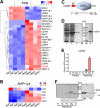A CTL - Lys immune function maintains insect metamorphosis by preventing gut bacterial dysbiosis and limiting opportunistic infections
- PMID: 38448930
- PMCID: PMC10918859
- DOI: 10.1186/s12915-024-01855-8
A CTL - Lys immune function maintains insect metamorphosis by preventing gut bacterial dysbiosis and limiting opportunistic infections
Abstract
Background: Gut bacteria are beneficial to the host, many of which must be passed on to host offspring. During metamorphosis, the midgut of holometabolous insects undergoes histolysis and remodeling, and thus risks losing gut bacteria. Strategies employed by holometabolous insects to minimize this risk are obscure. How gut bacteria affect host insects after entering the hemocoel and causing opportunistic infections remains largely elusive.
Results: We used holometabolous Helicoverpa armigera as a model and found low Lactobacillus load, high level of a C-type lectin (CTL) gene CD209 antigen-like protein 2 (CD209) and its downstream lysozyme 1 (Lys1) in the midgut of the wandering stage. CD209 or Lys1 depletion increased the load of midgut Lactobacillus, which further translocate to the hemocoel. In particular, CD209 or Lys1 depletion, injection of Lactobacillus plantarum, or translocation of midgut L. plantarum into the hemocoel suppressed 20-hydroxyecdysone (20E) signaling and delayed pupariation. Injection of L. plantarum decreased triacylglycerol and cholesterol storage, which may result in insufficient energy and 20E available for pupariation. Further, Lysine-type peptidoglycan, the major component of gram-positive bacterial cell wall, contributed to delayed pupariation and decreased levels of triacylglycerols, cholesterols, and 20E, in both H. armigera and Drosophila melanogaster.
Conclusions: A mechanism by which (Lactobacillus-induced) opportunistic infections delay insect metamorphosis was found, namely by disturbing the homeostasis of lipid metabolism and reducing 20E production. Moreover, the immune function of CTL - Lys was characterized for insect metamorphosis by maintaining gut homeostasis and limiting the opportunistic infections.
Keywords: C-type lectin; Ecdysone; Lipid metabolism; Lysozyme; Pupariation.
© 2024. The Author(s).
Conflict of interest statement
The authors declare that they have no competing interests.
Figures








Similar articles
-
20-hydroxyecdysone transcriptionally regulates humoral immunity in the fat body of Helicoverpa armigera.Insect Mol Biol. 2014 Dec;23(6):842-56. doi: 10.1111/imb.12131. Epub 2014 Sep 15. Insect Mol Biol. 2014. PMID: 25224836
-
An entomopathogenic fungus exploits its host humoral antibacterial immunity to minimize bacterial competition in the hemolymph.Microbiome. 2023 May 20;11(1):116. doi: 10.1186/s40168-023-01538-6. Microbiome. 2023. PMID: 37210573 Free PMC article.
-
The steroid hormone 20-hydroxyecdysone induces phosphorylation and aggregation of stromal interacting molecule 1 for store-operated calcium entry.J Biol Chem. 2019 Oct 11;294(41):14922-14936. doi: 10.1074/jbc.RA119.008484. Epub 2019 Aug 14. J Biol Chem. 2019. PMID: 31413111 Free PMC article.
-
Research Progress on the Regulation of Autophagy and Apoptosis in Insects by Sterol Hormone 20-Hydroxyecdysone.Insects. 2023 Nov 12;14(11):871. doi: 10.3390/insects14110871. Insects. 2023. PMID: 37999070 Free PMC article. Review.
-
The Gut-liver Axis in Immune Remodeling: New insight into Liver Diseases.Int J Biol Sci. 2020 Jun 23;16(13):2357-2366. doi: 10.7150/ijbs.46405. eCollection 2020. Int J Biol Sci. 2020. PMID: 32760203 Free PMC article. Review.
Cited by
-
Longitudinal dynamics of intestinal bacteria in the life cycle and their effects on growth and development of potato tuber moth.Front Microbiol. 2025 Jun 18;16:1542589. doi: 10.3389/fmicb.2025.1542589. eCollection 2025. Front Microbiol. 2025. PMID: 40606155 Free PMC article.
References
-
- Moran N. Adaptation and constraint in the complex life cycles of animals. Annu Rev Ecol Syst. 1994;25:573–600. doi: 10.1146/annurev.es.25.110194.003041. - DOI
MeSH terms
Substances
Grants and funding
LinkOut - more resources
Full Text Sources
Molecular Biology Databases

